Slowdown in residential property price rises in Manila
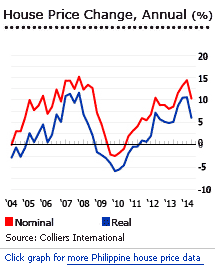 Despite the impact of one of the greatest typhoons in history, the Philippine economy continues to grow, and its property market continues to rise - though at a slower pace than before.
Despite the impact of one of the greatest typhoons in history, the Philippine economy continues to grow, and its property market continues to rise - though at a slower pace than before.
- In Makati central business district the average price of a luxury 3-bedroom condominium rose 13.4% during the year to Q1 2014, to PHP136,533 (US$ 3,043) per square metre (sq. m.) (8.98% inflation-adjusted). The price rise of 1.2% during the latest quarter (Q1 2014) was the lowest since Q2 2012, according to Colliers International.
- In Bonifacio Global City the average price for a 3-bedroom condominium increased by 9.5% to PHP 133,175 (US$ 2,968) per sq. m. (5.3% inflation-adjusted), or a 1.1% q-o-q growth.
- In Rockwell Center, the increase was 9.4% to PHP 140,178 (US$ 3,124) per sq.m. (5.1% inflation-adjusted), or a q-o-q increase of 1.0%.
Since Benigno (Noynoy) Aquino III became president in June 2010, he has instituted a no-holds barred anti-corruption and good governance campaign which has wowed foreign investors and caused consumer confidence to surge. Rising investment, plus low interest rates, have increased condominium prices by 36.4% (18.9% inflation-adjusted) between Q3 2010 to Q1 2014. Property prices have risen as much as 113.3% (34.1% in real terms) from 2004 to 2014. Philippine property experienced the fifth highest price rise in the world during the year to Q1 2014, according to the Global Property Guide’s Q1 2014 report.
Real estate loans country-wide increased by 25% to PHP 843 billion (US$ 19.9 billion) during 2013 according to the Bangko Sentral ng Pilipinas (BSP), the country’s central bank - a substantial rise, but a reduction on real estate loan growth in 2012, which soared by as much as 34%.
Land values continue to appreciate. In Makati CBD, land values rose by 8.2% in Q1 2014 from the previous year; in Ortigas Center, by 5.6%; and in Bonifacio Global City, by 8.2% y-o-y. Makati CBD land prices are now PHP353,795 (US$7,885) per square metre.
The Philippines is now one of the fastest growing economies in Asia, with 6.6% growth forecast by the IMF for 2014, behind only China (7.4%). Moody, Standard & Poor’s, and Fitch Ratings, all upgraded the Philippines’ investment rating to investment grade last year. Based on the Global Competitiveness Index of the World Economic Forum, the Philippines ranked 59 out of 148, up from 65 last year.
However all these improvements depend partly on the political environment. The next presidential election is only two years away. The front-runner is Jejomar Binay, vice-president, former Mayor of Makati, who has a strong reputation for competence - but a weak reputation for financial probity.
Philippine residential property is still below pre-Asian Crisis values!
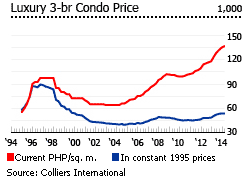
Surprisingly, despite so much price appreciation, the Philippine housing market has still not recovered from the crash after the 1997 Asian Financial Crisis. Between 1997 and 2004, luxury condominium prices dropped 30.4% (53.7% in real terms), in the biggest property crash of all countries affected by the Asian Financial Crisis.
In current price terms, both rental rates and property values are back above 1997 levels. However residential property prices in Q1 2014 are still 39.9% below pre-Asian Financial Crisis levels in real, inflation-adjusted terms.
Rents have plateaued
The average rental yield for condominiums in Metro Manila is at 8.66% in October 2013 according to the Global Property Guide research:
- The highest returns are on the 80 sq. m. units with gross rental of 9.4%, suggesting an oversupply of the very smallest condos.
- Yields are also high on very large condominiums, at around 7.5%, the highest in the region.
Rents are starting to plateau. While some districts are still experiencing rental growth, albeit at a much slower pace, rents in some areas are static or even decreasing in real value:
- The average rental price for a luxury 3-bedroom unit in Makati CBD was PHP 810 (US$ 18) per sq. m, a 0.6% increase on the previous quarter.
- In Bonifacio Global City rents on similar apartments rose 0.6% to PHP 815 (US$ 18) per sq. m..
- In Rockwell, the q-o-q increase of 0.2% to PHP 875 (US$ 20) per sq. m., was dwarfed by the 1.3% q-o-q inflation during Q1 2014. Adjusting for inflation, rents decreased by 1.1% during the latest quarter in Rockwell.
Gross rental yields are high, but beware taxes
According to research by the Global Property Guide, gross rental yields in Metro Manila are high, ranging from 7.53% on 120 sq. m. condominiums, to 9.09% on the very smallest condomiiums of 30 sq. m.
These yields are before taxes and other expenses. They were for the high-end areas: Makati CBD, Ortigas CBD, Rockwell, The Fort, and Eastwood City.
This does not mean that foreign investors should necessarily rush to invest in Manila, because transaction taxes (known as ‘capital gains taxes, but not actually such), and (if observed) official income tax rates applicable to non-resident investors, are high.
Low interest rates
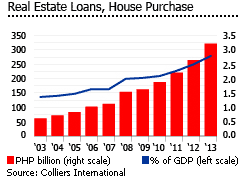
The BSP kept its policy rates at 3.5% for the overnight borrowing or reverse repurchase (RRP) facility in June 2014, and 5.5% for the overnight lending and repurchase facility (RF).
Most borrowing is short-term. Housing loan rates charged by major commercial banks range from 5.3% to 7.8% for one-year fixed loans, and from 7% to 10% for mortgages with fixed rates for five years.
Real problems impede the growth of the mortgage market. Few major banks offer housing loans, although loan-to-value ratios of 90% are now being offered, and loan tenors can be as long as 30 years. Different banks’ loans have strangely similar terms and conditions, and approval of loan applications takes a long time. Land titling and registration problems are prevalent, as are delays in the foreclosure process.
Property buyers also face high transaction costs, corruption and red tape, fake land titles and substandard building practices. Plus, the large informal housing sector and their incentives, make it less attractive for low to middle income families to buy or rent properties.
Because of these factors, the ratio of housing loans to GDP remains small, at around 2.8% of GDP in 2013. Most houses in the Philippines are sold for cash or pre-sold, with the developers offering financing.
Is oversupply developing?
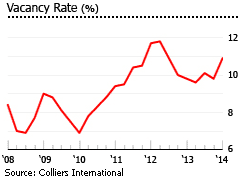
There were 57,710 condominium units in Metro Manila in 2013. Colliers anticipates 8,180 new units will come onto the market each year over the next four years. Newbuilds will push the stock of condominiums in Makati CBD, Rockwell, Fort Bonifacio, Ortigas, and Eastwood up to 90,436 condominium units by 2017.
Will demand be able to keep up? The condominium vacancy rate in Makati CBD was 10.9% in Q1 2014, up from 9.8% in Q3 2013.
Arguably however this vacancy rate increase is artificial. Colliers attributes the increase to turnover of new units. Premium three-bedroom units, it says, are still experiencing virtually full occupancy, with only a 4.6% vacancy rate.
JLL (formerly Jones Lang Salle), sees a small oversupply in the short term. This “little oversupply” of homes involves property projects launched six years ago and now coming online, pulling rental rates temporarily downwards. JLL sees 2014 as the year when supply will peak; however, they see no signs of a property bubble brewing.
Manila’s segmented market
Lower down the income scale there is cause to worry.
There are three identifiable segments in Manila’s housing market:
- The high end. This is the segment discussed by JLL. Local high-earners and expatriates occupy this segment.
- The middle tier. The mid-end condominium sector, with monthly amortization of around PHP 10,500 (US$ 235), presently requiring a dispensable income greater than PHP 34,962 (US$ 783), to obtain a housing loan of PHP 2 million (US$ 44,801). This segment has been targeted by many developers, and is attractive to overseas foreign workers (OFWs).
- The low end. This is where the mass of the population live.
We believe that the middle tier is over-supplied. Many of these lower middle-class condominium developments are ghost cities.
Manila’s ghost cities
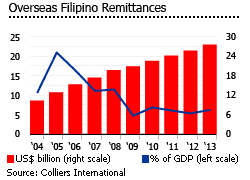
A visit to any ‘Barrio Fiesta’ in any city where Philippine OFWs work abroad is dominated by condominium offerings from developers like Megaworld, DMCI, Ayala Land, etc.. The Philippines is one of the world’s largest remittance recipients, with 10.5 million Philippine Overseas Foreign Workers (OFWs) living and working in 210 countries and territories worldwide, 47% of them permanent migrants, 40% temporary, and the rest "irregular migrants". Among the permanent overseas Filipinos, 65.2% live in the US, followed by Canada (13.1%), Europe (7.1%), Australia (6.8%), and Japan (3.4%), according to the Commission on Filipinos Overseas (CFO). In 2013, remittances from OFWs grew 7.4% to US$22.9 billion, or around 8.4% of GDP.
It is estimated that 60% of these remittances go directly or indirectly to the real estate sector, according to the World Bank. These OFW remittances power the low-end to mid-range residential property market, housing projects and mid-scale subdivisions in regions near Metro Manila, such as Cavite, Batangas, and Laguna Provinces.
According to the Philippine Housing and Land Use Regulatory Board, 452,198 condominium units were built in Metro Manila from January 2001 to March 2014. There are around 807,496 families or 27.5% of the NCR population who have a dispensable income greater than PHP 34,962 (US$ 783), which is the required monthly income to be able to afford the monthly amortization of PHP 10,500 (US$ 235). PHP 10,500 (US$ 235) is the minimum monthly amortization for a housing loan of PHP 2 million (US$ 44,801), with accommodating loan rates of 90% LTV, with an annual interest rate of 5.7%, and a loan tenor of 30 years.
So for all these newly-built condominiums to be occupied by those who could afford to rent or buy (we calculate for the buying case, but given current interest rates it may be more expensive to rent), 56% of locals who have the financial capacity to occupy them would need to do so, i.e., 56% of the 807,496 families with the financial capacity to do so, should purchase or rent a unit, for the available supply of condominium units to be taken up.
These are problematic numbers given that many of these families already have houses in the first place. The World Bank assumes only 10% of these capable end-users as prospective end-users, indicating a gross oversupply.
In terms of affordability, property developers are building more mid-end condominium units than locally-based Filipinos can afford to occupy. Many of the buyers are OFWs, causing a mismatch between demand and supply.
However the inflow of new OFW money has slowed, since the global financial crisis. Average annual growth of remittances was only 6.9% from 2009 to 2013, compared to 16.8% annually from 2004 to 2009. The World Bank believes the slowdown in remittances is due to:
- Stricter Implementation of the migrant workers’ bill of rights;
- Political uncertainties in host countries; and
- The slowdown in the advanced economies.
A puzzle – why are call-centre workers under-housed?
By 2016, it is estimated that as many as 1.3 million people will be employed in the BPO sector. The sector is expected to generate as much as US$ 25 billion in annual revenue.
BPO agents are likely to wish to rent residential spaces near their workplaces due to their night shift schedules. Since BPO agents have foreign countries as their clientele, their work hours follow suit. This means that most BPO employees work at the night time where commuting is risky while taxi cab fares are expensive.
There is a puzzle here. The income of this rising demographic overlaps with the investments made by the OFWs. Many call-centre agents are in the targeted income-bracket. But anecdotal evidence suggests that many of condominiums bought by OFWs are in the wrong place for call-centre agents.
In any case, the bottom line is that their spending-power is not yet strong enough to absorb supply. Many have family obligations and prefer to live at home or with relatives.
Maybe this will change. The Philippines will also soon experience a demographic ‘sweet spot’. The country has the third youngest population in the ASEAN region, next only to Lao PDR (median age of 21 years) and Cambodia (median age of 22 years). Based on its demographic profile, we can expect a strong demand for starter homes.
“Affordable” housing
The Philippines has a huge housing need at the low end. There are as much as 300,000 households in Metro Manila residing in informal and uninhabitable housing units which composes 8.7% of the total Metro Manila population.
These people live in appalling conditions. Many others live in very poor conditions.
To meet the needs of these families, the government embarked on the National Shelter Program to provide housing for informal settlers and other families who do not have enough income to rent nor buy houses in the prevailing markets rates.
Socialized housing units, or those which cost less than PHP 450,000 (US$ 10,800) can be purchased with a monthly amortization of PHP 2,302 (US$ 56). The Pag-Ibig Fund, (which is the Filipino word for love), the country’s state-owned and subsidized housing loan provider, provides a fixed rate of 4.5% for 30 years for socialized housing units.
The problem is that these low-end housing units are usually far from work.
Robust economic growth despite calamities
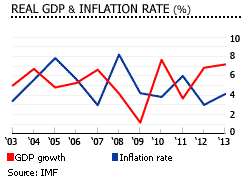
The International Monetary Fund foresees 6.6% GDP growth for the Philippines in 2014.
The Philippine economy grew by 7.2% in 2013, after GDP growth of 6.6% in 2012, 3.9% in 2011, and 7.6% in 2010. According to the International Monetary Fund (IMF), from 2000 to 2009, the economy expanded by an average of 4.4% annually.
The second half of 2013 was very challenging for the Philippines. Yet despite Haiyan, one of the strongest typhoons ever recorded, the Philippines exceeded expectations with 7.2% GDP growth during 2013, 0.2% higher than IMF forecasts.
The disruption in the agricultural production in the Visayas regions, which bore the brunt of Haiyan, and its subsequent effects on the supply chain, have led to the slower growth rate of the agriculture sector. Much of the 5.7% growth can be attributed to the Philippines’ consistently growing service sector with 6.1% growth during Q1 2014, which also accounts for 70% of the economy.
As of April 2014, the unemployment rate dropped to 7% from 7.5% in January; however, the data should be viewed with a grain of salt as the extent of the damage in one of the badly hit provinces in the country, Leyte, prevented the conduct of the Labor Force Survey by the Philippine Statistics Authority.
Among the ASEAN 5 (Indonesia, Malaysia, Singapore, the Philippines, and Thailand), the Philippines’ unemployment rate (7.5) is the highest.
In 2013, the Philippines registered a PHP 164 billion (US$ 3.7 billion) budget deficit. This is equivalent to 1.4% of the GDP, this is a decline from 2012, where budget deficit to GDP ratio is 2.3%. The country’s budget deficit stood at PHP 242.8 billion (US$ 5.54 billion) in 2012.
Headline inflation was 4.1% in April 2014; this is an increase from the average in 2013 of 3.0%, according to the BSP. The Philippines had an average inflation rate of 3.7% annually from 2010 to 2013.